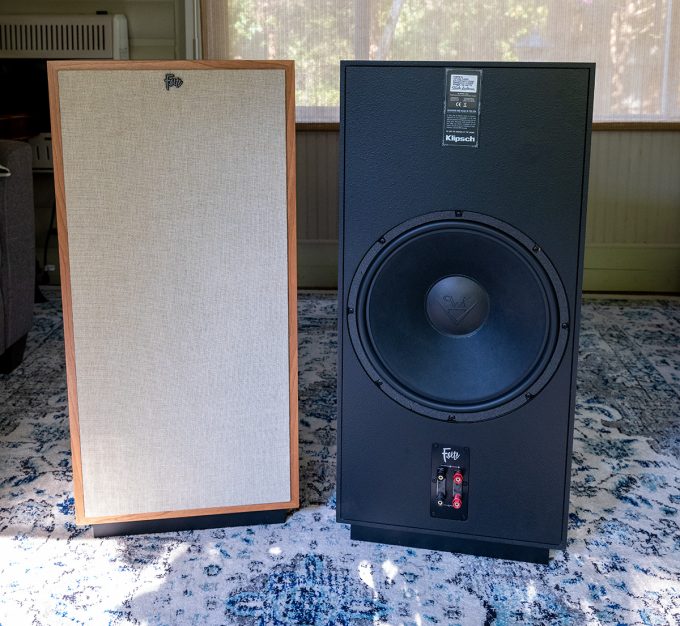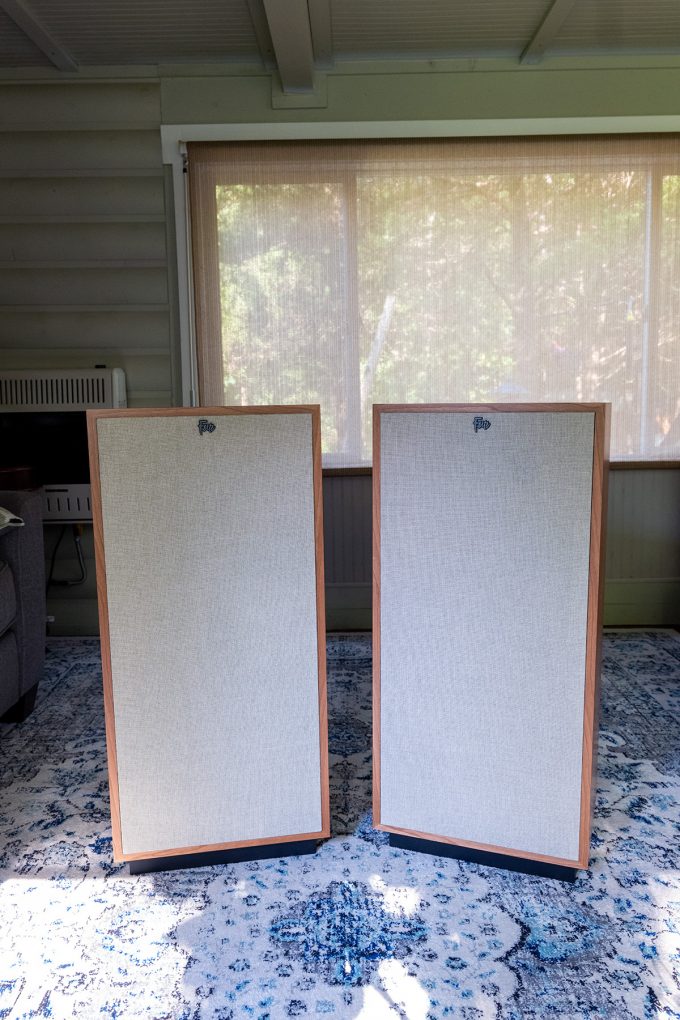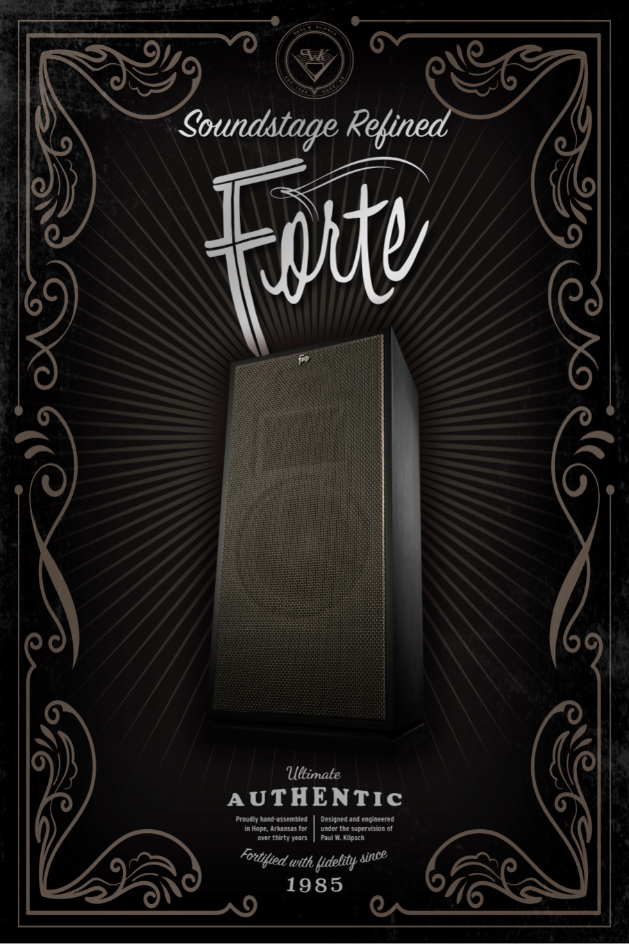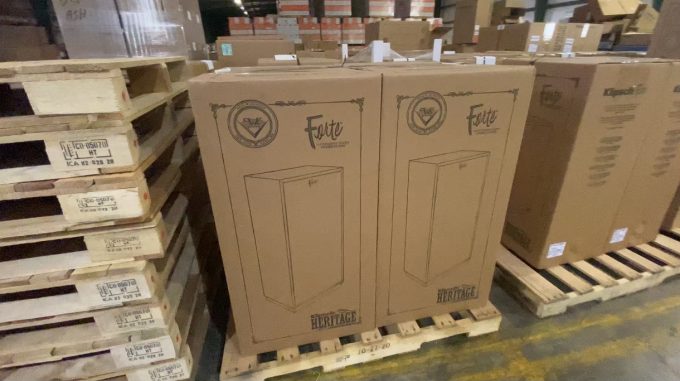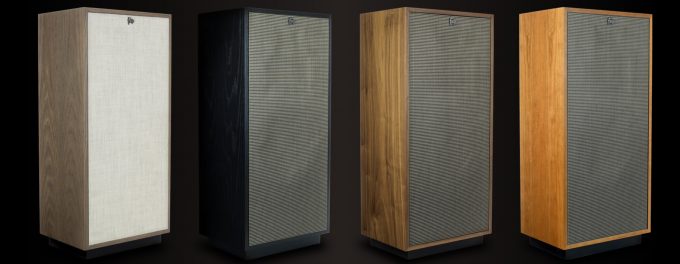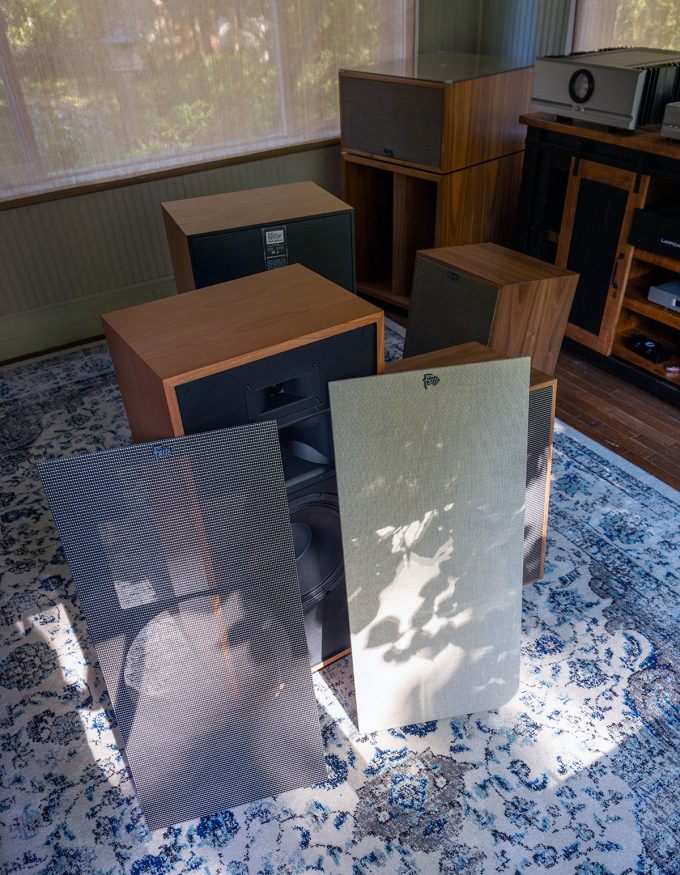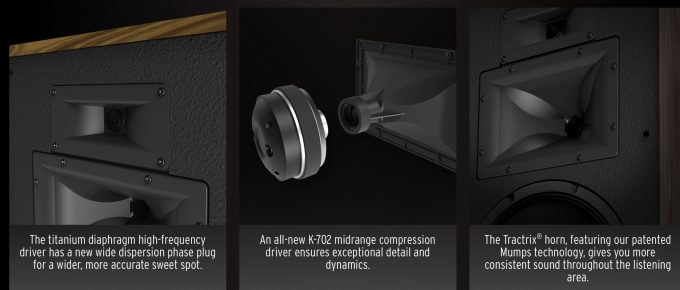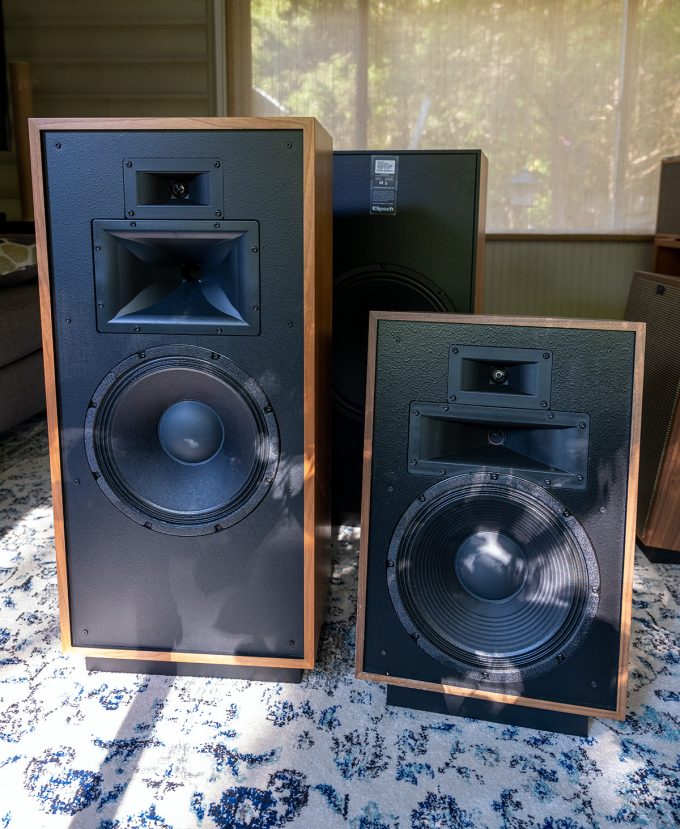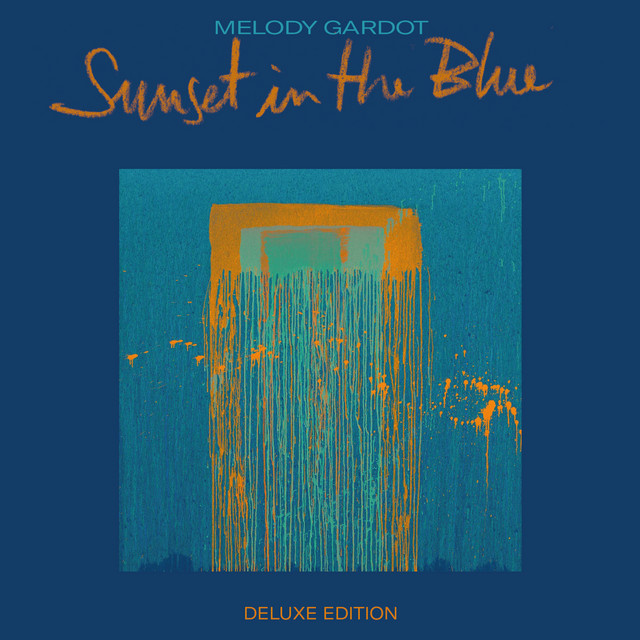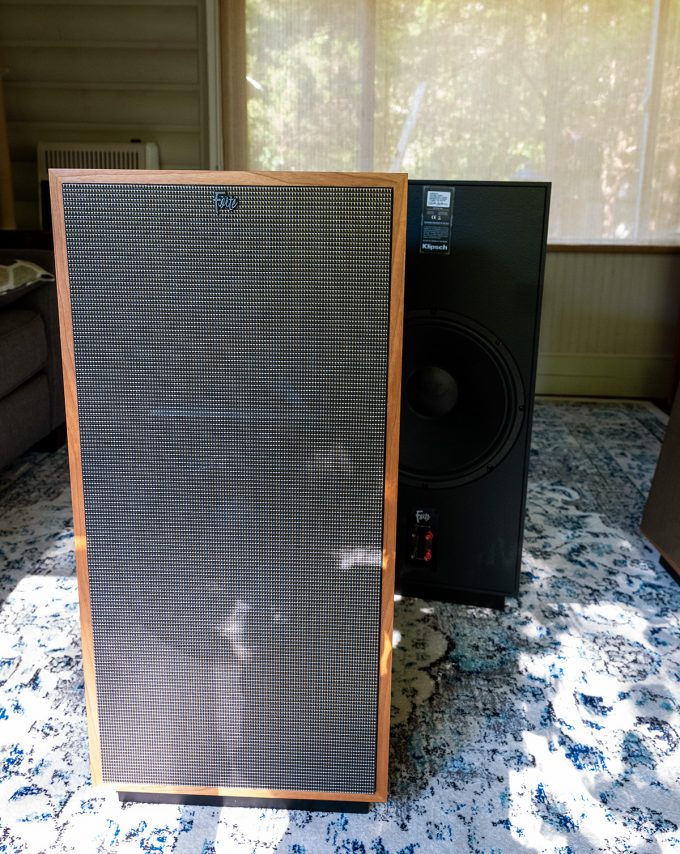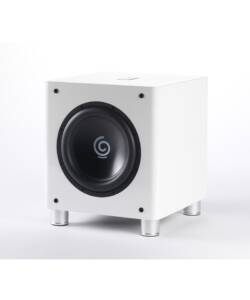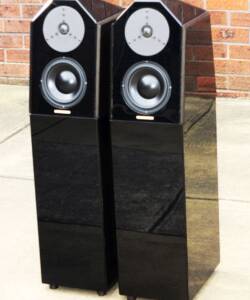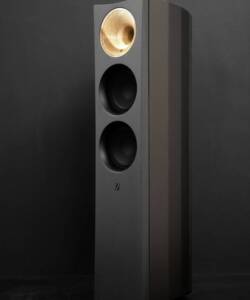Klipsch Forte IV Floorstanding Speakers [Black Ash]
Original price was: R175,000.00.R51,000.00Current price is: R51,000.00.
Specifications
Description: Three-way, horn-loaded, floorstanding loudspeaker.
Drive-units: titanium-diaphragm, K-100-TI 1″ (25.4mm) compression driver affixed to a 6″ × 4″ K-79T horn, tweeter; K-702 1.75″ (445mm) polyimide compression driver paired with a 10″ × 7″ K-703-M horn, midrange; K-281 12″ (305mm), fiber-composite cone woofer; KD-15 15″ (381mm) passive radiator. Frequency range: 38Hz–20kHz.
Sensitivity: 99dB/2.83V/m.
Nominal impedance: 8 ohms.
Dimensions: 35.75″ (908mm) H × 16.63″ (422mm) W × 13″ (330mm) D, Weight: 72lb (32.7kg) each.
Finish: American walnut, natural cherry, black ash, or distressed oak.
Price: $4500/pair.
Description
It wasn’t that long ago that I sat down to write my review of the Klipsch LaScala AL5 Speakers. While the LaScala have always been “Dream Speakers” for me, after 35 years of chasing “The Sound” I knew I had something very special in my room once they were placed within it. It was as if the music started to flow through them like blood flows through our veins…giving life to the sound. It was so so right and no matter the music I played, they sang their hearts out and sounded downright gorgeous doing it.
The LaScala’s offered me everything I have been looking for in a speaker and while the size of these beasts are not for all rooms or for everyone they can indeed work in rooms that are not huge or even large. In my 12X18 room the LaScala are the best I have ever heard in my 35 years of HiFi.
When it comes to musicality, enjoyment of the music and the realistic presentation of live music that sounds electric, visceral and exciting these are truly special instruments that breathe music. I listen to all genres through them. Jazz, Vocal, Rock, Metal, Bluegrass, Pop and whatever else I am in the mood for.
Even so, not everyone will be able to bring in a speaker such as this into their space. They are huge, heavy, expensive and depending on your tastes may look gorgeous or may look a bit odd.
The Forte IV’s are indeed re-voiced from the III just like the Heresy IV and Cornwall IV.
The good news is that Klipsch has a few models in the Heritage lineup that can suit any space or need. The even better news is that they all have the same overall sound character. Big, Real, Spacious and with superb vocal and instrument reproduction. These latest Klipsch Heritage models are speakers you should hear if you are passionate about music. Yes, Paul W. Klipsch knew what he was doing back in the day when he designed those first models but today Klipsch has amazing people who have made them even better than before.
The new Klipsch Heritage series have been KILLING IT and for me and my ears THIS is what music reproduction should sound like. After hearing the LaScala in my space, I can not go back to any other speakers in that room. When I do, I lose many things. Scale, realism, and the live feel of a real musical performance. I lose the effortless ease in the way the music is reproduced. It’s the way the vocals come in to the room that do it for me. Lifelike and with a super eery realism that will NEVER EVER bore you. They draw me in to the music like none other, regardless of cost of the “others”. This is why I chose them as my reference system speakers.
The Heresy IV (my review), The Cornwall IV (review) and LaScala (review) have all been reviewed here on these pages and in video as well.
Oh and BTW, I loved them all as all of them are excellent for their intended purpose. All of the Heritage speakers have a purpose for the right size room and space. No matter what model you go for rest assured you will get the Klipsch Heritage sound in your space as they do all share the same live and exciting sound signature but you do get more of the good as you move up the line.
The front and. back of the Forte IV. The 15″ Passive Radiator helps bring serous kick and deep bass to your music.
The One I Never Heard is the Forte
Today I want to talk about the Heritage speaker that so many consider the Sweet Spot in the Klipsch Heritage lineup, the Forte IV. It is taller than the short and squat Heresy IV and thinner in width than the Cornwall IV yet the Forte IV offers more than just a “smaller bigger speaker” over a Cornwall or a Heresy. In fact, this is the only Heritage speaker to offer a 15″ passive radiator in the rear for more kick and depth to the bass. The is in addition to the 12″ woofer in the front!
Yes, these are quite different from the rest of the Heritage line just because of this reason. While the similar sound character is still there these are the speakers in the Klipsch Heritage family that do sound the most like an expensive audiophile speaker. Wether that is a good thing for you or not is up to your tastes but I have been enjoying these beauties for a little while now and they have surprised me again and again. Thee are not like the Klipsch of old my friends, rather these are top tier beautiful speakers that I will share all my thoughts about below.
The new Forte IV has also been completely re-voiced from previous versions and uses more premium parts where it matters.
When I placed them in I wasn’t sure what to expect in my room. I assumed I would possibly have TOO MUCH bass with these beautiful beasts but seeing that I have never reviewed a set of Forte speakers, I was excited to give them a try.
I have owned my Heresy IV’s since launch. I have owned the Cornwall IV and also now own the LaScala’s. I have become quite a huge fan of the modern day Klipsch heritage sound as you can tell!
But first…A Thank You
My good friends over at Paducha Home Theater are the ones responsible for this review as they sent over a set of Forte IV’s for me to check out after I showed interest in them when I bought my LaScala’s. They also sent over a set of extra grilles, the super cool Lambs Wool variety that are usually reserved for the distressed oak versions of this speaker. Turns out when you buy a set of Forte’s from Paducah Home Theater you can also customize the grille and have a set like these sent along with your order (if you so desire and want to pay for them). They will also send you a super cool poster (if they have stock) along with them and these posters are gorgeous.
The set of Forte IV’s they sent over were the Cherry Forte IV with the included salt and pepper grilles and the lambs wool grilles. I think the Cherry models look amazing with both grilles but especially nice with the lambs wool. They are certainly beautiful to look at.
BTW, before I get to the review I want to say that Cory at Paducah Home Theater offers these speakers (and all Klipsch) at an amazing price so if you are in the market for ANY set of Klipsch, be sure to call them (270-556-8427) first and get a price quote. They also have tons of stock, ready to ship. I should know as I was able to visit their warehouse and see it for myself. A super group of people over there in Paducah and I want to thank them for this opportunity. See their website HERE.
Inside the Paducah Home Theater Warehouse
The Forte IV Listening Experience.
When the speaker arrived (they ship via freight on a pallet due to the size and weight) I managed to get them unwrapped and off the pallet easily even tough they are large and quite heavy at 72lbs each (when unboxed). With that said, I had to have them shipped to my Mom’s place because I live so remote that semi trucks can not use the roads around here. I am very rural and the big rigs will not drive here. It was a bit of a drive to get them but they arrived one day after they shipped, which was crazy. I drove out to my mom’s place and met the truck driver on delivery day after he called and told me he would be there at a specific time.
After I brought them home I was able to set them up with a little help from Debby. She helped me unbox them and then it was easy to place them where they needed to be.
Soon, I had them set up in my dedicated listening room and started playing some tunes I know well. The first thing that struck me was that they sounded different from the Heresy, Cornwall and of course LaScala. The big overwhelming bass I was expecting was a no show and they sounded a bit more detailed on top and a tad thinner in the mids than the LaScala and even the Heresy. Of course these were brand new factory fresh speakers so I let them run in for about 8 hours and then came back to listen again.
When I cued up some good old rock and roll and cracked them up these Forte IV’s KICKED ME IN THE CHEST with Bass when called upon. This bass is not in the mids though, so you will not get that muddied up midrange that can sometimes come with a fat mid bass. Rather the Bass is in the bottom. The Depths. The lowest registers. It plays bass that the LaScala misses entirely and this is what makes the Forte IV’s remarkable. If you love your deep bass, you will absolutely love the Forte IV and I would say even more than the Cornwall IV. No, even the mighty Corns can not do this kind of dramatic kick and punch with deep deep bass.
If it is a deep driving bass you are after let me say it again. The Forte IV’s can deliver it cleanly and without boom or mud. These are tight and have a punch that is superb for music that thrives with that punch.
IMAGING is SUPERB with the Forte IV
Song after song I was impressed with the way these speakers image. I would say that these are best imaging speakers that Klipsch makes in the Heritage line and they image better than some high end bookshelf speakers I own. In this area, they beat my much more expensive LaScala. The sound character here is clean, sparkly, detailed, large and 3 dimensional and the Forte IV do these things very well and moreso than the other offerings. These are audiophile in sound and still offer that engaging live real sound that Klipsch is known for. In my room and system these are also the most “treble centric” of the Heritage speakers meaning that have a bit more sparkle up top and with this comes the air and precise instrument separation. They are not as warm leaning as the Heresy IV our LaScala and sometimes they can sound a little bit more forward than those speakers.
As I have hinted at in other recent Heritage reviews, there’s something very special about all of these Version IV speakers from Klipsch. These are no longer shouty, overly colored in sound nor are they harsh in any way, shape or form. Klipsch of the past (70’s and 80’s) had these kind of issues at times and is why so many say (and think) that Klipsch can be bright. Today’s Klipsch is not bright at all, nor do they have ear piercing highs. No matter what model you choose in the Heritage line the new models offer up a slice of musical bliss and models should be chosen by your likes and desires rather than just size.
Two versions of the Forte IV grilles. Lambs Wool and Salt and Pepper. You can also see the Heresy and the LaScala along with a Pass Labs XA60.8 Monoblock.
A Quick Comparison
For example, the Heresy IV’s offer alot of what the Forte IV and Cornwall IV do. They just sound a bit smaller, a bit warmer and work best in smaller rooms. The Heresy IV are like mini Cornwalls in the way they produce sound. They bring the same character and with some pretty nice bass on tap due to the new rear port.
The Forte IV bring more of the audiophile sound to the table and have amazing imaging and soundstage with an even bigger sound than the Heresy. That passive radiator in the back brings in the deep bass that NONE of the other Heritage speakers can muster. For rock, metal, rap, hip hop, EDM and music with a kicking deep bass, the Forte IV truly do rule the roost.
The Cornwall IV’s just sound so fluid and offer up a huge wall of sound with the same overall vibe as the Heresy but sounds as if you stacked 4 Heresy IV’s together on each side of the room! The Cornwall’s do not bring the ultra low deep tight bass that the Forte IV’s bring but they have a fuller sound through the midrange bringing a bigger voice with vocals and even instruments.
The LaScala’s bring the biggest sound of all, with a gorgeous smooth and warm leaning midrange that makes it appear you are not missing any bass at all, even though they do not do deep bass. The magic with the LaScala is all in the voice, the midrange which is absolutely mind blowing good.
I have to say though, the Forte IV’s are truly in that sweet spot in the Heritage range if you ask me. They are not nearly as wide or massive as the Cornwall in size yet they are not short and squat like the Heresy. They look gorgeous in the flesh and truly look and feel like the high end speaker that they are. They can fit into almost any space and the bass in my 12X18 space was never ever bloated or overcooked. In fact, for some music they sound a little less full than the little Heresy which brings the detail more forward on the Forte IV’s. But they never sound bright when running them with the pass labs amplification I have here.
POWERING THESE SPEAKERS
This brings me to something I want to talk about. Amplification.
These speakers and all of the heritage line will sound different depending on how you drive them. I have run these with many amps and the sound ranged from thinner and brighter to bigger and fuller all depending on the amp I chose to run them with.
With something like a Naim Atom the Forte’s sounded a bit hotter on top and thinner in the mids and I would say this amp is not a great match with the Forte IV. With a Cary 300 SEI tube amp the Beauty of the sound came out but the amp itself hummed so bad it made it unusable with the speakers.
The transformer of the Cary hummed/buzzed and therefore hum was pouring out of the speakers due to the speakers high sensitivity. This was with a brand new Cary 300 SEI I was going to review. I had another one delivered and it had the same issue. I therefore concluded that this amp should never be used with any high sensitivity speakers yet that is what this amp was made for. Had me scratching my head but two defects? Maybe. In any case, I would not recommend this amp with Klipsch speakers though from what I could hear the 300B character is very nice with the Forte. Just a thinner sound than what I hear with Pass Labs.
With a $500 Chinese el34 tube amp (THIS ONE)the sound was plump and musical as can be but lost out on overall resolution and mid bass. It was very nice and well worth the cost but the sound was again, a bit thinner.
The Forte IV next to the Heresy IV
With a Pass Labs INT25 integrated there was serious magic happening. It was full, fluid, detailed and holographic and was so so so smooth and powerful sounding. With the Pass Labs XP-10 and Xa60.8’s running all Class A the sound was about as magical as it could be.
After using many amps with all of the Klipsch Heritage (latest Version IV’s) speakers I consider Pass Labs a perfect synergistic match with them. There is absolutely NO hiss, NO noise and the silent black backgrounds are awesome to have with such sensitive speakers. With Pass there is a touch of warmth, big bass, full body and ever so sweet details with a big wide soundstage bringing the performance to the room.
I have also heard them with a Yamaha integrated and a PS Audio Sprout 100. They sounded good but not as good as the tube and pass options above. To me the Yamaha amps add a bit of dryness to Klipsch speakers. You may not hear this unless you compare it to something else, but it is there. The Sprout is great for the cost but you can get much better sound from the speakers than this little amp can muster.
So how you power these speakers matter and from my experience todays Klipsch is not necessarily better with tubes. To me, Class A solid state power is what these speakers love the most and this is what brings out the body, life, sparkle and bass that you want from these.
Sure, there are Class A tube amps that could and may be gorgeous and I plan in trying a couple of them soon as I did hear magic with the Cary 300 SEI when I blocked out the noise/buzz with my mind : ) I knew it would have been special if it were quiet and I would love to hear a nice 300B design with them. As of now, I love the combo of Pass Labs and Klipsch Heritage. The Cary SLI 80 HS is supposed to be wonderful as well and Klipsch even recommends this amp with these speakers. I have not heard this combo.
RESOLUTION
The Forte IV do offer the same sound signature and character as the other Heritage Speakers. You can even hear this for yourself in this video I made comparing the Heresy IV, Forte IV and LaScala all playing the same song:
While you will not hear what they sound like in my space you can tell that these all have the same house sound. In person though, the Forte IV are slightly more detailed/sharper and have that amazing passive radiator that adds quite a bit of bottom end to the music.
Listening to “High by the Beach” by Lana Del Rey can be a great judge of the bass performance of your system. This song overdoes the bass in my opinion and if your speakers can handle it without boom and mud then you have a great set of speakers. The Forte IV brought out this bass in such a remarkable way due to that passive radiator. It’s so clean, so impactful and so “OOMPH”!
It doesn’t boom or muddy up the mids or highs and that is important as not all speakers can accomplish this feat. When I play this though the Heresy IV the bass is much less pronounced and doesn’t allow me to feel it. Through the LaScala this song sounds fantastic but that big bass is well, missing. Even so, it sounds full bodied and amazing through the LaScala, which is the special trick that those speakers can do.
The Forte IV’s present the music with a wider soundstage than the Heresy’s and with more air. The instrument separation is also quite impressive with the Forte’s and they do so with more precision than any other of the Heritage speakers. This is why I say they are the most audiophile speakers of the bunch. They somehow accomplish this while remaining immensely musical and bringing that same live energetic sound to your space.
What about small scale jazz or vocals?
Playing “If You Love Me” from Melody Gardot her vocals are dead center and so realistic with the Forte but compared to the Heresy IV and LaScala the midrange is a bit different. It’s cleaner/not as full bodied and a little more recessed as if she is farther back the room.
These speakers focus on the whole rather than a part of the music. While the LaScala’s magic lies in the mids, and the Heresy does very well with acoustic instruments the Forte do their best to deliver the goods in all areas. From top to bottom. There were some songs I preferred the Forte and some I preferred the Heresy. I do not see either speaker as better than the other but I will say I do prefer the looks and style of the Forte over the Heresy. It all comes down to your personal tastes and what you like.
The Forte IV are more traditional looking and would really look stunning in any space. They also come in black, cherry, walnut or distressed oak. Take your pick.
At the end of the day the Forte IV are another set of wonderful speakers from Klipsch. They have a little more top end energy than the Heresy, Cornwall and LaScala but this can bring a more visceral electric live feel with some music. These are the only set in the Heritage line that has deep kicking thumping chest rocking bass and also the most audiophile sounding of the line.
I think it’s awesome that Klipsch has such an impressive lineup of speakers in the Heritage line and if I can be honest, they are some of the most musically satisfying speakers I have heard in my life. They breathe music and bring out the nuances and realism of the performance.
The Forte IV are truly the sweet spot as they offer it all and will fit in to almost any space. I will also say that after about 100 hours on the speakers they opened up quite a bit, and relaxed a little. They sound gorgeous and I have a hard time picking which set to listen to on some days. That right there says alot.
If I were to buy a new set of Klipsch from Scratch and I was deciding between these and the Cornwall IV I would choose these over the Cornwall IV unless my room was HUGE simply due to the passive bass radiator in the back. This makes a ton of difference if you like that deep bass kick that is clean, tight and fast as all get out.
Bravo to Klipsch. They have done it again! Highly Recommended.
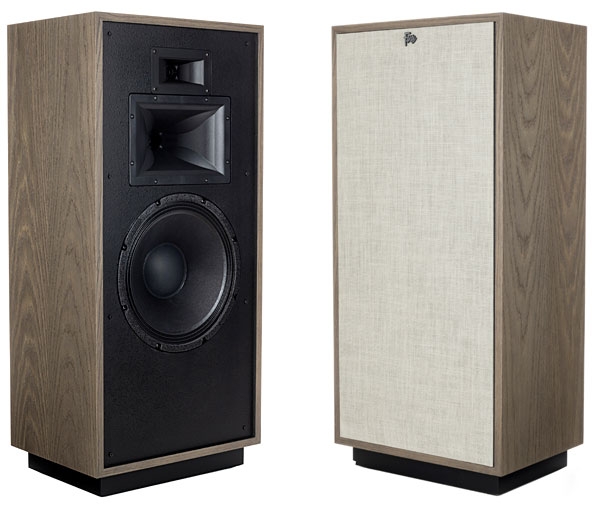
No one taught me more about the heralded tone of Ortofon SPU cartridges, the magical pacing of idler-drive turntables, or the dynamics and speed of horn-loaded speakers than Art Dudley, Stereophile‘s late deputy editor. His equipment reviews and monthly Listening columns weren’t merely tutorials on how to review audio equipment with insight and an individual voice; they were also an entertaining, informative immersion into the kind of hi-fi he loved. We also shared many conversations, though too few.Whenever Art lacked the time or interest to review a horn-loaded speaker, I pounced. Between May 2017 and August 2019, I reviewed the Volti Audio Rival, the Burwell Mother of Burl, the Klipsch Heresy III, and the Klipsch Forte III. In my review of the Forte III, I praised its reproduction of percussion, writing, “the entire drum set had its own distinct stage, each decay, cymbal ring, and drum resonance part of a larger percussive whole that poured forth from the Forte IIIs with exhilaration.” The III offered solid “bass reproduction, some CDs or LPs creating visceral yet agile, creamy yet forceful” sounds. The Forte made the most of jazz trios: “I could easily hear the moments of contact between Ray Brown’s fingers and his bass strings, [Shelly] Manne’s sticks and drums, [Barney] Kessel’s pick and guitar strings—those instants when action becomes visceral music.”
The Forte IV
On its surface, the Klipsch Forte IV appears almost unchanged from its predecessor (footnote 1), and the IV’s specifications are identical to those of the III. Both are three-way, horn-loaded, floorstanding loudspeakers. The frequency range of both is specified as 38Hz–20kHz, the sensitivity 99dB/2.83V/m at 8 ohms nominal impedance. The dimensions are very close: The IV is ¼” shorter (now 35.75″; 908mm) and 0.13″ wider (now 16.63″; 422mm) than the III. Both are 13″ (330mm) deep, and both weigh 72lb (32.7kg) per speaker. Both models come in American walnut, natural cherry, black ash, or distressed oak. The IV is priced at $4500/pair, $500 more than the III.
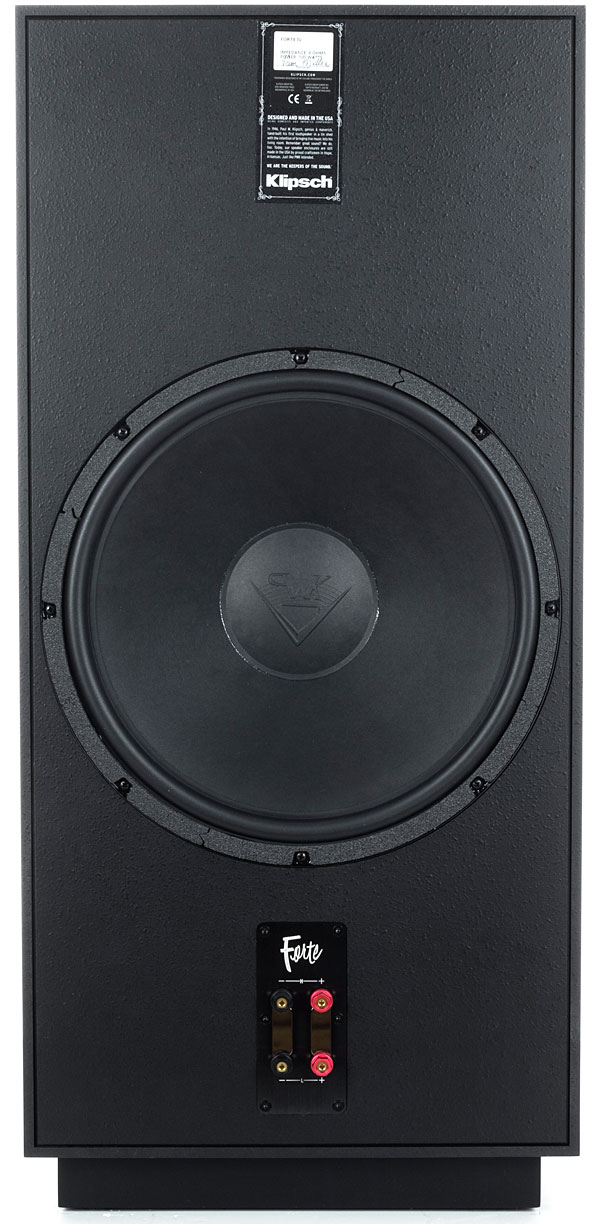
There are other important differences. On the IV, the high-frequency driver—a titanium-diaphragm, K-100-TI 1″ (25.4mm) compression driver affixed to a 6″ × 4″ K-79T horn—has added an ABS phase plug “for a wider, more accurate sweet spot,” Klipsch says. There’s a new midrange: the Celestion-made K-702 1.75″ (445mm) polyimide compression driver paired with a 10″ × 7″ K-703-M horn. The combination is said to ensure “exceptional detail and dynamics.” The two bass units—the K-281 12″ (305mm), fiber-composite cone woofer and, on the back panel, a KD-15 15″ (381mm) passive cone radiator—are unaltered.
What else? Klipsch says that the IV has been “completely revoiced from its predecessor, utilizing premium componentry in an all new high-fidelity network—minimizing electrical degradation throughout the circuitry—for truer to life sound with best in class efficiency and power handling.” The new crossover network, Klipsch says, was influenced by the crossovers in the Klipschorn and the La Scala. “When I first came to Klipsch, Paul [Klipsch] was working on steep-slope networks,” designer Roy Delgado told me during a phone call. “Paul evolved with his science on speakers. When he got the anechoic chamber, that created possibilities to get a lot more resolution. He would do tests and over the years update the networks, because he felt you would learn something new about the combination of drivers we had.
He felt that the weakest link was the crossover.
“We brought in the steep slope, which we also use in the Klipsch cinema speakers,” Delgado continued, “because I wanted to make them efficient in their bandwidth; it also added a protection that wouldn’t mess up the driver because of its strictly limited bandwidth. So, when we were redoing the Heritage series, I designed a steep slope crossover for the Forte IV.” The specified crossover frequencies remain the same, and yet, Delgado told me, “The difference in the networks between the Forte III and Forte IV is not subtle.”
I wanted to hear that for myself, so I wrestled the Forte IVs from their boxes, furloughed my DeVore Fidelity Orangutan O/96 speakers to the hallway, and pushed the Forte IIIs into the living room.
I used a variety of equipment in various combinations with the IVs, with Tidal streaming via Roon from my laptop to the preamp section of an Ayre EX-8 2.0 integrated amplifier (in for review). After that, the signal went either to the EX-8’s amplifier section or to the LKV Research Veros PWR+ class-D power amplifier (specified at 200Wpc into 8 ohms). A 2m run of AudioQuest Forest USB cable connected laptop to preamp’s internal DAC, a 2m pair of Triode Wire Labs Spirit II interconnects joined the preamp to the power amp, and an 8′ run of AudioQuest Robin Hood speaker cables linked the IVs to whichever amplifier was in use. I used A/V Room Service Equipment Vibration Protectors (EVPs) under the IV’s 2″-high support pedestal.
Listening inside the box
I immediately heard in the IVs a refinement and poise that the IIIs, for all their virtues, lacked. The IIIs have a little bit of the character of the fat-boy, low-rider Klipsch Heresys: energetic, dynamic, and just a little rough around the edges. The IV sounded smoother and richer than the III from the midrange through the upper treble, and the soundstage was deeper.
I listen to Fortes toed in so that they fire directly at my listening seat 66″ away, with the speakers 61″ apart on center. The IIIs could sound beamy in that configuration, but with the IVs,
I never heard that; instead, I heard a slightly wider soundstage and a more open, transparent top end. The IVs sometimes sounded a wee dark overall, which I didn’t mind.
Reproduced by this system, the voices of female vocalists sounded full and natural. Listening through the circuslike production and extreme dynamics of St. Vincent’s “Pay Your Way in Pain,” from Daddy’s Home (16/44.1 MQA, Loma Vista/Tidal), bass drum and toms were rock-solid and tight and electric bass was oily and deep. St. Vincent’s vocals imaged beautifully within a wide, immersive stereo spread: The IVs imaged better than the IIIs, no doubt about it. Daddy’s Home was detailed and colorful through the IVs—although this album’s production is much too slick and processed for my tastes. Equally glossy but seeming more genuine, Becca Stevens’s “Low On Love” from Wonderbloom (16/44.1, GroundUP Music, Tidal) combined silken vocal textures, tactile synth bass, and ear-tickling harp images within a big soundstage.
The Forte IV’s high end was explicit but not harsh; the midrange was clear and full; low end was full and weighty and, in my room, sometimes lacked a little definition. That would improve in a larger room where bass waves generated by a 12″ woofer and a 15″ passive radiator could develop fully. The IVs didn’t play with the richness, definition, or soundstage depth of my DeVore Fidelity O/96s, but they got closer than their $7500 difference in price would lead you to expect.
The IVs rocked dynamics and visceral textures like every Klipsch model from time immemorial (or from 1946, to be precise). Tom Petty’s “Running Man’s Bible” (16/44.1 MQA, Reprise/ Tidal), from Mojo Tour Edition, had potent snap and punch, as if my head was locked down between Steve Ferrone’s Gretsch bass drum and Ron Blair’s Fender Jazz Bass. k.d. lang’s “Lifted by Love,” from her surprising electronic-remix dance album Makeover (16/44.1 MQA, Tidal/Nonesuch), whirled through my head hyper-real textures, senses-saturating drums (including the sampled hide of a classic Roland TR-909 bass drum), and her soaring, luxurious vocals. I felt fully in touch with Tom and k.d.’s beating hearts, their power emanating their mouths to my heart. Klipsch speakers do “live” better than any speaker I’ve had in my madman Greenwich Village digs save Volti’s Rival.
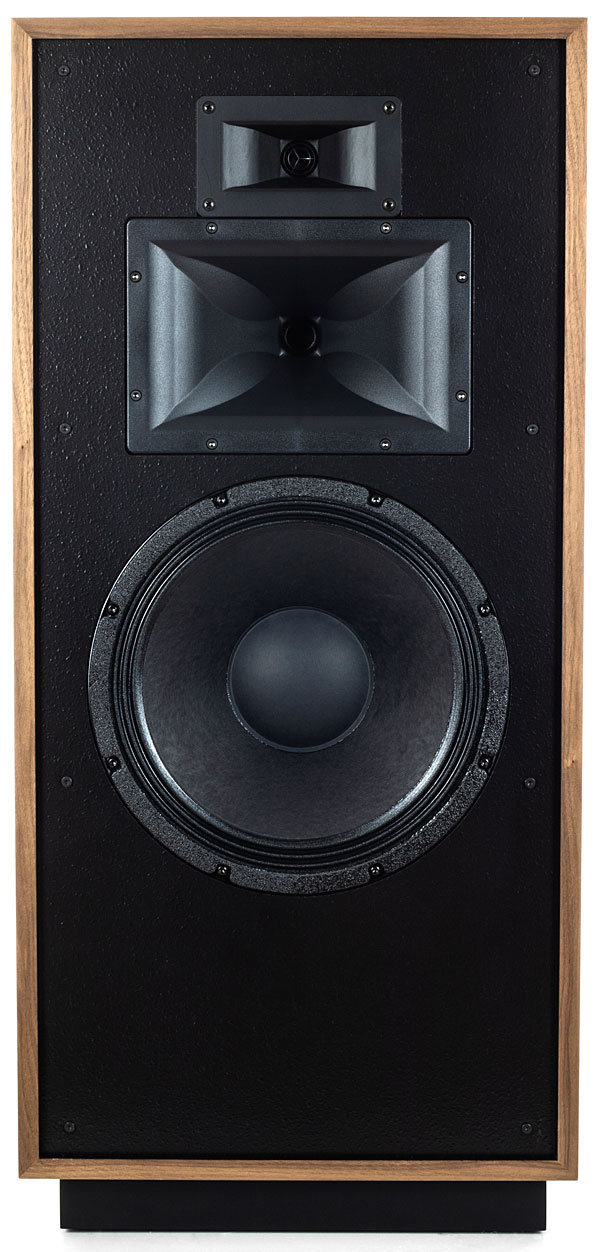
The Roon/Ayre/LKV Research Veros PWR+/Forte IV streaming setup gave a final blast of visceral music reproduction with I Percussionisti della Scala’s performance of Karlheinz Stockhausen’s “Zyklus” from Percussion Masterpieces (16/44.1 FLAC, Tidal/Stradivarius). I collect percussion albums, and this one is a stunner in its performance and its natural sound. After an opening gong strike that resonated through my cranium and washed over my body, the IVs presented every mallet strike, drum-head palm rub, metal brush stroke, bell, marimba, and timpani enunciation with touchable textures, rich tones, and dreamy note decays. As I upped recording quality, the IVs upped their game.
Switching to vinyl brought increased naturalness, even better dynamics, and an improved sense of presence from the IVs, with a slight loss of image specificity and treble smoothness. The IVs were very transparent to both recordings and equipment, exposing the character of every amp I used, from the LKV Research Veros PWR+ to the Parasound Halo Hint 6. The IVs didn’t play with quite the full scale of my Thorens TD 124/Jelco TS-350s/Denon DL 103 vinyl front-end is capable of, but they did reproduce music as gutsy and natural-sounding.
The Enigma Variations, from Variations, Op.31 (LP, London Records CS6984) with Sir Georg Solti conducting the Chicago Symphony Orchestra, charged out of the IVs with churning dynamics, practically knocking me out of my padded IKEA Poäng. Though the stage was no larger in dimension than when I was streaming digits, notes had better depth, complexity, and density. The orchestra was reproduced with force and solidity. On the Great Jazz Trio’s Direct from L.A. (LP, East Wind EW 10005), Tony Williams’s drums had great weight, and Ron Carter’s bass had deep traction. Jo Jones’s dancing brush strokes on “Sweet Georgia Brown” from Jo Jones Trio (LP, Fresh Sounds FSR-617) were real and physical, as if “Papa Jo” was slapping stiff wire brushes on my head, not the drumhead.
Parasound Halo Hint 6
Inserting the Parasound Halo Hint 6 integrated amplifier (160Wpc into 8 ohms) brought further surprises. The soundstage was smaller than with the LKV Veros, but now everything on stage was more precise. I heard more top-end air, giving ride cymbals dimensional resonance and “ping,” and acoustic bass notes sounded more concentrated, hence more emphatic. Richard Davis’s acoustic bass intro to “Short Story” from tenor saxophonist Joe Henderson’s In ‘N Out (LP, Blue Note 80 Vinyl Edition 00602508027734) was punchy and powerful. I detected a glint of hardness in the climaxes of Elgar’s Enigma Variations, but overall I thought the neutral-sounding, $2995 Parasound amp a better fit for the Forte IVs than the Veros had been. Which is surprising, since the Halo Hint 6 never worked that well with the IIIs.
Shindo Allegro and Haut-Brion
Old school cognoscenti insist you use a tube amp to drive horn-loaded speakers, so I wired in my Shindo Allegro preamp and Haut-Brion power amp and gently lowered the spherical stylus of the Denon DL-103 into the spinning black grooves of the Great Jazz Trio’s Direct from L.A.
Herb Reichert says “tube watts are not the same as solid state watts,” and that proved true. The 20Wpc Shindos were easily, profoundly better with the Forte IVs than the solid state amps had been. The life-affirming jazz swing pumping out of the Fortes had more impact, tonal beauty, force, and weight, and the images were larger. I was floored by the wall of sweet-toned sound coming at me like a warm music wave. With the Shindo/Forte IV pairing, all was flesh and blood, texture and tension. Hank Jones’s piano glistened, Tony Williams’s drums had terrific tone and weight, and Ron Carter’s bass was upfront and present—all rich and first-row palpable.
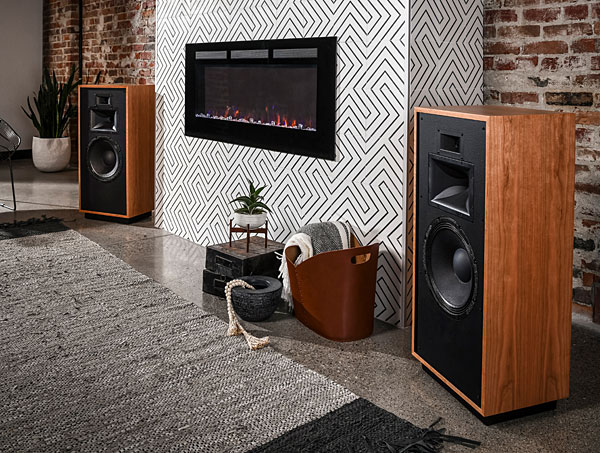
IVs meet IIIs
With much grunting and huffing, I swapped out the IVs for the IIIs, rejuiced my system, and placed my 1961 mono “New York NYC” Blue Note deep-groove pressing of The 3 Sounds’ Feelin’ Good (Blue Note BLP 4072) on the Thorens platter. I turned on the clunky power switch, lowered the stylus, and scurried back to my listening perch.
The 3 Sounds are perhaps Blue Note’s only lost jazz act. No one cares for them outside of rappers looking for samples; their records go for a pittance. But between 1958 and 1971, pianist Gene Harris, bassist Andrew Simpkins, and drummer Bill Dowdy performed and recorded with an old school swing pulse that was engaging and relentless. They recorded nearly 20 albums for Blue Note and more for the Riverside, Mercury, and Limelight labels.
Feelin’ Good is prime 3 Sounds. Through the IVs, it captivated with rich, sparkling piano, tactile, snappy drums, and deep-rumbling acoustic bass. The IVs were coherent from midrange through the treble; the IIIs sounded more disconnected. Gene Harris’s piano sounded harder through the IIIs, and if Bill Dowdy’s drums seemed more integrated with the soundstage via the III, it was because the snare drum and cymbals were pushed forward and not because the drums were deeper in the stage.
Summing Up
The Forte III is a fine-sounding loudspeaker, but for an extra $500, the Forte IV is more coherent, sweeter, smoother, and more refined, with a better-defined top end, a warmer midrange, and the same trademark dynamics and low-end weight as the previous Forte version.
![Klipsch Forte IV Floorstanding Speakers [Black Ash]](https://audioexchange.co.za/wp-content/uploads/2024/07/klipsch-Forte-IV-fro.jpg)
![Klipsch Forte IV Floorstanding Speakers [Black Ash] - Image 2](https://audioexchange.co.za/wp-content/uploads/2024/07/klipsch-Forte-IV-aa.webp)
![Klipsch Forte IV Floorstanding Speakers [Black Ash] - Image 4](https://audioexchange.co.za/wp-content/uploads/2024/07/klipsch-Forte-IV-a6.jpg)
![Klipsch Forte IV Floorstanding Speakers [Black Ash] - Image 5](https://audioexchange.co.za/wp-content/uploads/2024/07/klipsch-Forte-IV-a5.jpg)
![Klipsch Forte IV Floorstanding Speakers [Black Ash] - Image 6](https://audioexchange.co.za/wp-content/uploads/2024/07/klipsch-Forte-IV-fr.jpg)
![Klipsch Forte IV Floorstanding Speakers [Black Ash] - Image 7](https://audioexchange.co.za/wp-content/uploads/2024/07/klipsch-Forte-IV-a2.jpg)
![Klipsch Forte IV Floorstanding Speakers [Black Ash] - Image 8](https://audioexchange.co.za/wp-content/uploads/2024/07/klipsch-Forte-IV-a1.webp)
![Klipsch Forte IV Floorstanding Speakers [Black Ash] - Image 9](https://audioexchange.co.za/wp-content/uploads/2024/07/klipsch-Forte-IV.webp)
